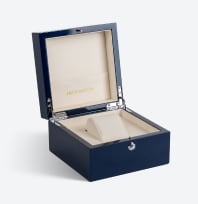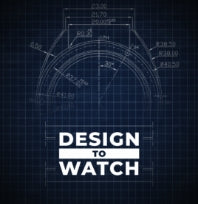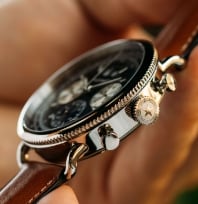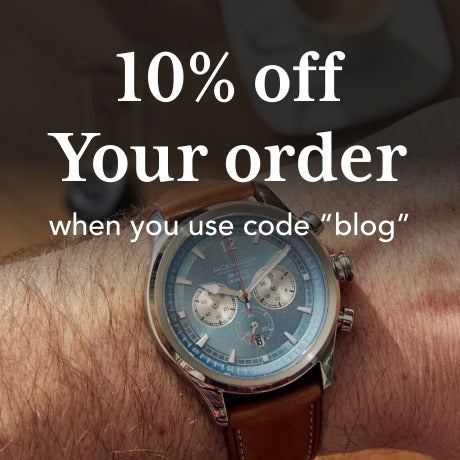Your watch can tell the world a lot about you.
A wristwatch can make a powerful and lasting impression when worn well. Complementing your outfit with the right watch can make a major difference in how you look, adding to your sense of put-togetherness and boosting your confidence. For all these reasons and more, wearing a watch is one of the simplest and most practical ways for a man to make a fashion statement.
When your goal is to let the world around you know that you mean business, a big-faced watch can be a powerful asset. Big-faced watches have a tendency to stand out – a watch with a large face often becomes the centerpiece of your outfit, whether you mean for it to or not. These watches tend to make an outfit exude confidence, giving your look the missing link it needs to be complete.
However, there are some key rules to follow when pairing watches with various outfits for different occasions. This post is all about choosing the right style of watch to compliment every setting. We’ll get into the details on what you want to know most – how to wear a big-faced watch and when to opt for something more subtle. In addition, we’ll cover some of the characteristics that you’ll want to look for in any wristwatch you buy, regardless of its style.
Choosing a high-quality watch is essential when you want to look your best. Well-chosen accessories like an excellent watch can make a major difference in the impression you leave on everyone you meet. It’s well worth it to take the extra time to explore and learn the rules of fashionable watch-wearing. Fortunately, we’re here to help you along the way.
Why Your Watch Face Size Matters
A watch’s face is the part of the watch that displays the time. A watch’s face may also include additional features known as complications. Complications give a watch additional functionality and convenience for the wearer. Some of the most common watch complications are date displays, dual-time displays, world timers, and chronometers. Some less common complications include moon-phase displays and planetariums, which are rarely found on modern watches, and tachymeters, which measure the speed of the wearer’s movement.
The bigger your watch’s face is, the easier it will be for you to read the display. In addition, interacting with any of the complications featured on your watch’s face is often easier when wearing a larger-faced watch. Watches with smaller faces often have simpler designs that do not include many complications.
In addition, smaller watches may not have room to display larger complications like chronographs or dual-time displays. These complications are much more common in specialized types of watches, such as timepieces designed for aviation, seafaring, and diving.
What Are The Most Common Types Of Big-faced Watches?
There are several types of watches that are typically made with bigger faces. Some of the most common types of big-faced watches are pilot’s watches, racing watches, and nautical watches.
Pilot’s watches were initially created to be worn specifically by professional airmen. The complications featured on the face of a pilot’s watch serve specific purposes for pilots. Pilot’s watches typically include dual-time displays and chronometers.
For pilots, these complications are extremely useful while in the air. The dual-time display revolutionized the pilot's watch design by making it possible for aviators to travel through multiple time zones and keep their watches accurate. The chronometers featured on pilot’s watches allow for the tracking and measurement of certain amounts of time elapsed.
Racing watches are similar in design to pilot’s watches and feature similar complications. These watches are also typically designed with bigger faces. The display on the face of a racing watch was designed to provide drivers with useful functions. The complications on a racing watch include a chronometer with a built-in tachymeter, which is used to track speed based on the time elapsed. Tachymeters have been a staple of auto racing for decades, and the racing watch design is steeped in the rich roots of decades of racing.
Wearing A Big-faced Watch Well Starts With The Right Strap.
Bigger-faced types of watches like aviation, nautical, and racing watches are suitable to wear with a wide variety of outfits in an equally wide variety of situations. Whether you are going to a black-tie event, heading to the office, or relaxing on the weekend, one of these watches can pair well with the rest of your attire. However, there are a few considerations to make before putting on a big-faced watch.
Think about the design of the rest of your watch. What is the strap made of? Is it leather? Metal? Canvas? Rubber? Each of these materials lends itself to specific dress codes, and the wrong strap material can make an otherwise appropriate watch unfit for a specific occasion.
When it comes to watch straps, metal and leather tend to be the most versatile materials to wear. These materials are also used to make the straps for most big-faced watches. The most formal watch strap material out there is black leather – in certain settings that are very, very formal, black leather is the only material you’ll want to wear for accessories like belts, shoes, and watch bands. In most settings, though, brown leather or metal is just fine.
Big-faced watches do not typically feature canvas or rubber straps. However, if you do have a watch that includes a strap made from one of these materials, it is probably best to save it for more casual settings. Field watches specifically are most often paired with canvas straps, and these watches are designed to be worn only in casual settings – they are often best fit for outdoor adventures or everyday wear with jeans and t-shirts. A field watch is an excellent timepiece to have in your rotation, but it might not be your best choice for a formal occasion.
As for rubber straps, these are less common when paired with analog watches. For digital and smartwatches, on the other hand, rubber is a much more common strap material. Rubber is typically a more casual material, often worn during workouts and other strenuous activity as a strap paired with a smartwatch. However, some analog watches do make good use of rubber straps, making the material fit right in with a formal outfit. Some dive watches, for example, feature rubber watch bands, and these bands look much more tasteful and formal than those featured on smartwatches and digital watches.
When Should You Wear A Smaller-faced Watch?
In some circumstances, a watch with a smaller face may be a better pairing for your outfit or for a specific occasion. Dress watches, the most formal style of timepiece, are typically designed with smaller, more discreet faces. These sleek, stylish watches typically pair a smaller face with a luxurious black leather band to achieve the highest possible levels of formality.
Dress watches are often paired with tuxedos and other very dressy outfits. However, in most settings, a dive watch or another tasteful, simple watch with the right strap can be just as at home in a very formal setting.
Big-faced watches are not out of the question in highly formal settings – it’s all about how you wear your watch. A big face and numerous complications do not make a watch stand out in a bad way, but they do certainly draw attention to your wrist. Wearing an elaborate pilot’s watch with a large face, chronometers, and other complications can perfectly complement a more formal outfit, but it may not be your best choice if you are aiming for simplicity.
Having more than one watch in your arsenal is ideal for achieving the maximum amount of perfect pairings with different outfits and occasions. The more versatile your wardrobe is, including your accessories like watches, the better prepared you will be for anywhere you go. If you own a big-faced watch, it’s a great move to have a smaller one with minimal complications on standby for days when you are going for a more subtle look. However, a big-faced watch, when worn right, can be right at home when paired with a wide variety of looks.
To make the most out of your big-faced watch, consider owning several straps made from different materials that are compatible with it. Switching out straps can often be all your watch needs to be compatible with a specific outfit.
Ultimately, it’s up to you to decide how you feel about wearing a watch that makes a big statement. A great-looking, high-quality watch can be paired well with just about any outfit when worn right and paired with a fitting strap. When it comes to your watch of choice, there are many more factors at play than just the watch itself. Choosing a good strap, staying aware of the context the watch will be worn in, and complementing your watch with other coordinated accessories can all make a major difference in how you pull off a look.
Sources:
https://old-sole.com/blogs/news/which-leather-is-more-versatile-black-or-brown
https://ashleyweston.com/mens-essentials-accessories/are-smartwatches-fashionable/
https://www.artofmanliness.com/articles/matching-your-watch-with-your-clothes/












